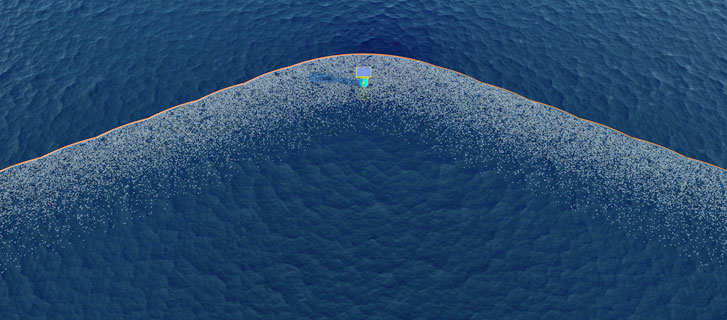Plastic Waste & The Ocean Cleanup
On July 19th, Science Advances published a study entitled “Plastics: Production, use, and fate of all plastics ever made.” Authored by Roland Geyer, Jenna R. Jambeck and Kara Lavender Law, the study combines global data on the life cycles of polymer resins, synthetic fibers, and additives into a comprehensive material flow model to provide “the first global analysis of all mass-produced plastics ever manufactured,” (Geyer, Jambeck, Law).
Plastics 101
Large-scale plastic production and use began in the mid-20th century. Today, plastics’ largest market is the packaging industry. While none of the commonly used plastics are biodegradable, the only way to permanently eliminate plastic waste is by destructive thermal treatment, such as combustion or pyrolysis. Unfortunately, plastic waste is not confined to landfills and recycling centers. Plastic debris has been found in all major ocean basins. In 2010 alone, an estimated 4-12 million metric tons of plastic waste generated on land entered the marine environment. According to Geyer, Jambeck, and Law’s research, plastic waste is so prevalent in the natural environment that it’s been suggested as a geological indicator of the Anthropocene era (Geyer, Jambeck, Law).
Hard Numbers
Let’s unwrap the numbers. Since 1950, 8.3 billion metric tons of “virgin plastics” have been produced. As of 2015, 6.3 billion metric tons of that total have become plastic waste. That’s 75.9% of all plastic ever produced. Now, of that 6.3 billion metric tons of plastic waste, 567 million metric tons (9%) have been recycled, 756 million metric tons (12%) have been incinerated, and 4.98 billion metric tons (79% of plastic waste; 60% of plastic total) have been relegated to landfills or the natural environment (Geyer, Jambeck, Law).
Here’s where we and perhaps some of you begin to hyperventilate. That’s okay—just don’t do it into a plastic bag. Those are hard numbers. And we at Remyndr are the last ones who want to admit that recycling won’t save the world.
Fear not! There’s hope yet!
The Ocean Cleanup
Engineers, entrepreneurs, and scientists are working to develop technologies that reduce plastic waste. One of our favorite foundations working toward this end is The Ocean Cleanup. Founded in 2013 by 18-year-old Boyan Slat, The Ocean Cleanup has developed a technology system that leverages natural ocean currents to remove plastic waste from the Great Pacific Garbage Patch. The Great Pacific Garbage Patch is the largest of five floating garbage patches around the world. The Ocean Cleanup’s passive technology is estimated to clean up 50% of the Great Pacific Garbage Patch within five years (The Ocean Cleanup).
How the Technology Works
The Ocean Cleanup’s technology system has four parts:
First, a recyclable floater made of high density polythylene floats on the ocean surface. The floater extends from a half mile to a mile in length and is deployed in strategic locations determined by The Ocean Cleanup’s algorithms.
Second, the floater attaches to a solid, fiber-reinforced thermoplastic polyurethane screen that catches sub-surface waste and allow fish to pass underneath with the current. Scale model testing shows that the screen can catch anything from one-centimeter plastic particles to discarded items several meters in size.
Third, the screen is anchored by a large sea anchor suspended at 600 meters below the ocean surface. Since water moves more slowly at greater depths, the anchor will make the system move more slowly than plastic waste, thereby capturing the debris.
Fourth, a support vessel empties the cleanup systems once they become full. With a system of belts and pumps, a ship will remove the plastic waste and ship it back to land to be processed, recycled, and resold (The Ocean Cleanup).
Read more about how The Ocean Cleanup’s technology works.
The Ocean Cleanup funded their pilot project, which will be deployed later this year. Their next step will be to develop refined iterations of their technology designs based on a series of tests. By mid-2018, The Ocean Cleanup will roll out its first operational cleanup system (The Ocean Cleanup).
What You Can Do
Be Mindful of Plastic
The easiest thing you can do to help is to become mindful of your plastic consumption. If you have a bag with you at the store, maybe tell the clerk that you don’t need another bag. If you like drinking cold water at home, maybe use a Britta filter instead of using plastic water bottles. If you love peppermint mocha frappuccinos all year round, who can blame you? But be mindful of recycling the cups in the appropriate bin. Sometimes it can feel like a hassle to separate your recycling by materials, but that has a deciding impact on whether your recycling ends up as waste or actually gets recycled. If you want a reminder of which items go where and when they get collected in your neighborhood, download the Remyndr app.
Get Involved in Your Communities
Local community groups are a great way to connect and get involved. Montclair, Cedar Grove, Nutley, Verona, Avon, Marshfield, and North Attleboro all have active Facebook Groups. Members discuss local ongoings in their neighborhoods, share advice on how to conserve energy and become more green, and sell or swap furniture, appliances, and hand-me-down toys. It’s always better to give away or sell an item before you throw it in the trash. In addition to the Remyndr Facebook Page, check out some of our favorite neighborhood Facebook Groups:
Verona / Caldwell NJ Buy Sell & Trade
Donate to The Ocean Cleanup
If you’re looking for ways to get involved with clean energy, The Ocean Cleanup now allows companies and individuals to fund their own ocean cleanup systems. With a tax-deductible donation, you can literally be part of the largest ocean cleanup in history. To learn more or make a donation, visit The Ocean Cleanup.
That’s a snapshot of what’s happening in the world of plastic waste and clean energy solutions. To stay up to date with these issues and your local neighborhood recycling schedules, visit the Remyndr Facebook Page and download the Remyndr app.



No Comments